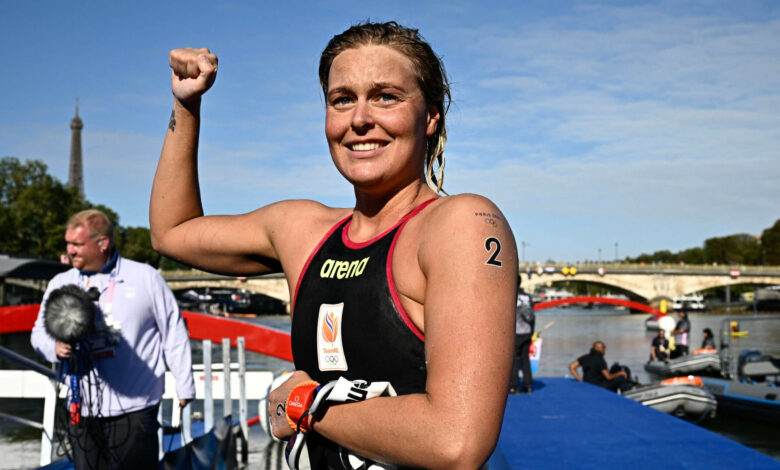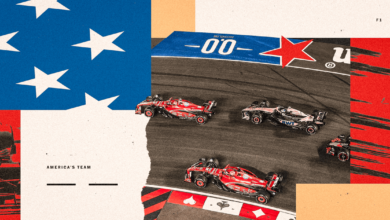Netherlands’ Van Rouwendaal dedicates Olympic gold in swimming marathon to dead dog

A week after the Olympic triathletes pioneered their way into the murky waters of Paris’s most famous body of water, two dozen of the world’s top marathon swimmers upped the ante.
Those triathletes went a mere 1,500 meters down and up the Seine, spending just 20 minutes in a river that only 24 hours before had been deemed too polluted for humans to safely enter. A week later, the marathon swimmers braved the waters for 6.2 miles, or 10,000 meters, a roughly two-hour morning dip into a waterway that had largely functioned as a massive urban sewer for 100 years.
When it was over, Sharon van Rouwendaal of the Netherlands thrashed and kicked through the water to out-swim Moesha Johnson of Australia over the final 500 meters to win her second Olympic gold medal in the women’s event. Van Rouwendaal — who later dedicated her victory to her dog, who died earlier this year — finished in two hours, 3 minutes, 34.2 seconds, 5.5 seconds ahead of Johnson and 8.6 seconds ahead of Ginevra Taddeucci of Italy, who captured the bronze medal.
Van Rousendaal, who led for the first hour of the race but fell to second for most of the second half, cut into the heart of the current in the final stretch and tore through the river to the finish line. Johnson, who also competed in the 1,500-meter race in the pool, could not cover the move.
A victory with extra meaning
After her win, Van Rouwendaal said her year started out great — but following her dog’s death in May, she didn’t care about swimming for three weeks.
“My world stopped,” she said. “But then my dad said, ‘Just see it like you have been away from him for seven years through competitions — just do one more race and give it everything and swim for him’.
“So I had a tattoo three days after the cremation and I said, ‘Let’s try it and I will swim for him with my whole heart’ — and I did it — I won for him.”
Johnson and Van Roewendaal train together and are close friends — the American described Van Roewandaal as “the GOAT (greatest of all time) of the sport”. Johnson believed she could win in the final stretch because everyone is beatable, but she was “stoked” with both the silver medal and the choice of location.

(Julien de Rosa/AFP via Getty Images)
The Seine has provided a unique location for the marathon
The Seine is dark, a shade of brown-black-green that doesn’t exactly scream, ‘Come on in, the water’s great’ even on the warmest summer days.
Every morning, officials with the Paris 2024 organizing committee, swimming’s world governing body and the local government’s leading environmental organization have been testing the water to make sure levels of E.Coli and enterococci are under the thresholds set for safe enough open-water competition. They have also been keeping a close watch on the weather.
Rain is the main problem, flushing pollution from the streets and the sewer system into the water, despite the construction of a $1.5billion sewage water retention system that was constructed ahead of the Games to help clean the river. It has helped but there is a long way to go.
A Belgian triathlete, Claire Michel, suffered from vomiting and diarrhea for three days following last week’s competition. She said tests showed she had contracted a virus, and was not suffering from E. Ecoli, as was previously feared. But whether bacteria from the river exacerbated the symptoms of the virus will never be known for certain.

GO DEEPER
What happens if the Seine isn’t clean enough in time for the Olympic triathlon?
Since this marathon swim became a part of the Olympic program in 2008, the races have taken place in either large, enclosed bodies of water, like the lake in London’s Hyde Park, or in bays off the coasts of Rio and Tokyo, both of which had no shortage of pollution. Paris brought the first river swim.
To the extent that the swimmers could peek up during the race, the Eiffel Tower, golden statues atop the Pont Alexandre III and the glass-topped roof of the Grand Palais drifted into their view. Open-water swimming, though, does not allow for much sightseeing.
Unlike racing in a pool, where swimmers follow a black line and flip every 50 meters, open-water racing in a murky river — or bay or ocean — largely means swimming blind when your face is submerged. You have to peek up every so often to make sure you are staying on track for the series of orange and yellow buoys that mark the course. With the best swimmers trying to maintain a stroke rate of 80-100 strokes per minute, a few strokes in the wrong direction at the wrong time could be the difference between winning and missing the podium.
The Seine brought another complication for swimmers more used to navigating waves forced to account for the rivers. After the first 1,500 meters, a very clear pattern emerged.
Swimming downstream during the first half of each of the six loops, the swimmers stretched out into a long line, the faster swimmers at the head of the lead and chase packs able to use their speed to build leads over those trailing behind.
But when they turned back east, heading for the start-finish and feeding area — yes, they flip on their backs and drink and eat while swimming during this race — beneath the Pont Alexander III, the current became the great equalizer, packing the swimmers together in a clump. They tried to minimize the damage by swimming close to the concrete wall on the Left Bank of the river, but there is a reason that the expression ‘swimming upstream’ gets used to describe the tasks that at are hard, frustrating and bordering on hopeless.

Swimmers are handed hydration bottles on sticks while competing (Julien de Rosa/AFP via Getty Images)
Tricky conditions for the athletes
Swimmers said they encountered some plastic bags, tree branches, rotted plants, and some other detritus, but they mostly put the water quality out of their minds and dealt with the immediate challenge of the current.
Katie Grimes, an American who finished 15th, a little less than three minutes back, described swimming against the current as “the hardest thing I’ve ever done.” Grimes finished 5th in the 1,500 in the pool last week.
Like many of the swimmers, she skipped the training session Wednesday for fear of getting sick from the water.
“You’re going against the current for a really long period of time and also just the turns going across the way was super challenging,” she said. Trying to grab some nourishment during the race was also difficult, “because the current was trying to push you back out towards the course.
Bettina Fabian of Hungary, who is just 19 and finished fifth, 42 seconds behind Van Rouwendaal, said she trained in the Danube River in her homeland leading up to the race, which got her used to the challenge of swimming upstream and helped her deliver one of the best performances of her career. That’s how she knew she was going to be staying in the middle going downstream and on in the wall heading back.
“I managed it well,” she said. She didn’t even mind the water quality, saying it tasted like a lake. Fabian did swallow a lot of water though but her coaches have a plan for dealing with that — Hungarian fruit brandy.
“I’m going to neutralize it with alcohol,” she added.
Johnson, meanwhile, said: “We’ve got the beautiful historical elements behind us and we’ve got the river currents and it’s all different and that’s what you train for.
“Wherever the next one might be like, I look forward to that challenge of the conditions and if you don’t want to have conditions like this, you may as well do a 10K in a pool. It’s a completely different event.”
(Top photo: Julien de Rosa/AFP via Getty Images)




